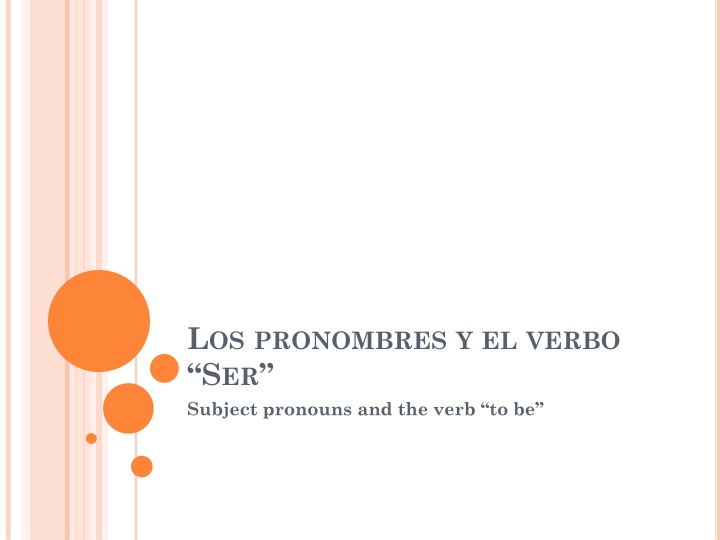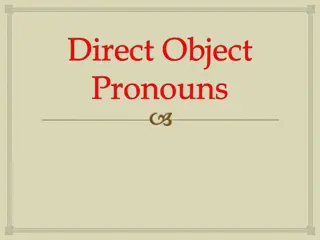Subject Pronouns and Verb 'Ser' Overview
In this guide, you will learn about subject pronouns in Spanish and how they are used with the verb "ser." It covers the different subject pronouns, conjugations of the verb "ser," when to use "tú" versus "usted," and the distinction between "ser" and "estar." Explore examples and clarifications to enhance your understanding.
Download Presentation

Please find below an Image/Link to download the presentation.
The content on the website is provided AS IS for your information and personal use only. It may not be sold, licensed, or shared on other websites without obtaining consent from the author.If you encounter any issues during the download, it is possible that the publisher has removed the file from their server.
You are allowed to download the files provided on this website for personal or commercial use, subject to the condition that they are used lawfully. All files are the property of their respective owners.
The content on the website is provided AS IS for your information and personal use only. It may not be sold, licensed, or shared on other websites without obtaining consent from the author.
E N D
Presentation Transcript
LOS PRONOMBRES Y EL VERBO SER Subject pronouns and the verb to be
PRONOMBRES PERSONALES SUBJECT PRONOUNS Subject Pronouns Yo T l Ella Usted I You He/it She/it You (formal)Ustedes Nosotros (-as) We Vosotros (-as) You (pl)* Ellos Ellas They They You (pl.) *Spain only
The T form is used to address a friend, a coworker or a a relative or a child. The usted form is used express deference or respect to a stranger, an elder or a superior. -Usted is often abbreviated Ud., ustedes, Uds. -Nosotros and Vosotros change gender when they refer to a group of women. nosotras and vosotras . When they refer to men and women together, use the masculine form Mauricio y yo=nosotros, Mar a y yo = nosotras - Ellos is used to refer to a mixed gender group or a group of men only. Ellas is only used in a group of all women. - Vosotros and the verb tenses that go with it (vosotros so s) are only used in Spain. In Latin American Spanish Ustedes is used as the plural of both Usted and T However, in certain parts of Latin America (esp. Argentina, Uruguay and El Salvador) the word vos is used instead of t and the conjugations vary between t and vosotros except without the I
EL VERBO SER THE VERB TO BE Ser To be (Yo) Soy (T ) Eres ( l/ella/usted) Es (Nosotros) Somos (Vosotros) So s (Ellos/ellas/ustedes) son I am You are S/he is/You are We are You are They are/You are
The verb Ser is not the only verb in Spanish that means to be , another verb Estar is also used to describe temporary emotional states. C mo est Enrique? = How is Enrique? C mo es Enrique? = What is Enrique like?. -Ser is used to describe permanent conditions such as nationality, personality, identity, place of origin and occupation. Yo soy canadiense. T eres pragm tico; tu amiga es rom ntica. Mi mam es doctora.
CONJUGATION OF ESTAR Yo T l, ella, Ud. Nosotros Vosotros Ellos, ellas Uds. estoy est s est estamos est is est n
-Using subject pronouns with verb conjugations is optional in Spanish, the conjugated form usually implies who the speaker is. In cases where there is confusion between several third persons the subject pronoun is used to clarify the subject of the action. Enrique es mi amigo. Es de colombia. Enrique y Mar a son mis amigos. Ella es mexicana, l es de colombia.
CARACTERSTICAS PERSONALES Personal and physical characteristics often use the verb Ser in Spanish. Adjectives of personal characteristics change gender or number with the speaker. Liberal Conservador (a) Rom ntico (a) Pragm tico Optimista Pesimista Estudioso Paciente Impaciente Atl tico T mido. Inteligente In pairs use the appropriate form of ser to describe the following: Yo Mi madre Mis mejores amigos Mi compa ero de cuarto Nosotros los j venes (millennials) T























